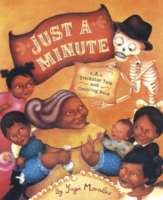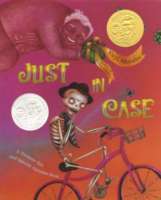by Julia López-Robertson, Tiffany LaBrooy, Kirstin Wade & Jamie Yobs, University of South Carolina
 This week a group of students read Yuyi Morales’ beautiful stories, Just a Minute and Just in Case. Just a Minute is a witty tale of Grandma Beetle who gets a surprise visit by Señor Calavera, a skeleton who has come to inform her that it is “time to go.” Grandma Beetle says she will go in “just a minute” after she sweeps one house, boils two pots of tea, makes three pounds of corn into tortillas… and on and on until she gets to ten where she informs her grandchildren that the
This week a group of students read Yuyi Morales’ beautiful stories, Just a Minute and Just in Case. Just a Minute is a witty tale of Grandma Beetle who gets a surprise visit by Señor Calavera, a skeleton who has come to inform her that it is “time to go.” Grandma Beetle says she will go in “just a minute” after she sweeps one house, boils two pots of tea, makes three pounds of corn into tortillas… and on and on until she gets to ten where she informs her grandchildren that the  tenth guest at her birthday party is Señor Calavera. When Grandma Beetle finished embracing each of her grandchildren she turned to look for Señor Calavera but could only found a note from him stating he would be back for her next birthday party!
tenth guest at her birthday party is Señor Calavera. When Grandma Beetle finished embracing each of her grandchildren she turned to look for Señor Calavera but could only found a note from him stating he would be back for her next birthday party!
Just in Case is the ‘sequel’ to Just a Minute and tells the story of Señor Calavera’s adventures as he tries to find Grandma Beetle just the right birthday present. The story follows Señor Calavera on his journey through the alphabet to find the perfect birthday gift. While gathering items he hears a voice that asks him “are they what Grandma Beetle would love the most?” Doubting what he has gathered so far, Señor Calavera continues his search and accumulates several gifts that correspond to each letter of the alphabet. But Señor Calavera did not find the perfect gift just yet…at the end of the story the perfect birthday gift arrives and surprises everyone including Señor Calavera.
Señor Calavera in the preschool
I spend time weekly in a multiage preschool classroom reading children’s literature in Spanish and engaging the children in songs and finger plays also in Spanish (http://wowlit.org/on-linepublications/stories/storiesiii1/9/). I have been in the classroom for four years and have known some of the children since they were three years old. A couple of weeks ago I read Just A Minute. Before I was able to even take the book out of my bag and before I had a chance to say a thing, the four and five year olds in the classroom shouted, ‘Señor Calavera, Señor Calavera! Look, it’s Señor Calavera!’ The three year olds, who are new to the class, had no idea what was going on but as is the case in most multiage classrooms, they followed the lead of the older children and shared their excitement. Even the teacher commented, ‘Ooo, it’s Señor Calavera, now you know I love him, so please let me listen to the story.’
The classroom grew silent as I took the book completely out and asked the kids to tell me what they saw on the cover. The children who have been in the classroom for a few years and I have a pact; ‘if we read a book that you know, you can’t tell the secret’. As difficult as it was, they remained pretty quiet during our opening discussion. Here is a bit of that discussion:
One of the three year olds said, while pointing to Señor Calavera, ‘Is that a skeleton?’ Another three year old said, ‘Yeah, and he is wearing a hat. Why is he wearing a hat?’
A new four year old said, ‘He got nothing to keep warm, why is he have a hat on?’
One of the four year olds couldn’t take it anymore and said, ‘It’s Señor Calavera and he still isn’t scary!’
Interestingly enough it wasn’t until the four year old made that comment that the idea of fear even entered the room and throughout our whole read aloud not one child ever mentioned being afraid of Señor Calavera. Why then are adults so quick to pass judgment on books such as these two by Yuyi Morales and deem them ‘inappropriate’ and ‘frightening for young children’ when in fact they aren’t, at least not to this group of twenty young children!
Señor Calavera at the University: Student Responses
Tiffany
This book [Just a Minute] is an excellent book to teach counting in English and in Spanish. It is also extremely rich in Mexican culture and is a great look into the beautiful traditions of the people of Mexico. It is important to have texts like this in a literacy library because it witnesses to children an appreciation for diversity and for learning about other cultures. Gerald Campano (2007) suggests that we “change school literacy from within” in order for it to “become deeply inflicted with personal meaning” (pg. 26). By providing students with literacy such as this book, children will better understand the lives, language, and traditions of other people. This book is an excellent way to learn about others! “Part of having access to a quality education involves learning with and from others” (Campano, pg. 50).
I thought this book was extremely unique and beautiful. The illustrations pull you into a whimsical world as if to make you feel at home. Although the writing was simple enough for children to comprehend, it had deep meaning behind the words. I also loved how they counted in English and Spanish. Not only is it a brilliant book, it is also a practical one to use in the classroom. This book really made me think about life and all that makes it special. I would highly recommend this book to anyone and everyone who wants something that is filled with meaning and an insight into the beauty of the Mexican culture!
Jamie
I like the fact that this author does not follow the “traditional” format but using common characters. The main character is a skeleton, which can be very controversial to some people. I think it is important to talk to the parents if you decide to use this in the classroom. As you said, [in class] they are usually more likely to be upset about things if they do not see the purpose and effectiveness behind this. The author has such great imagery throughout this entire book. I also like the way the book is laid out. Morales emphasizes certain words and phrases to show voice. This could be a great lesson to show children different ways to use voice. This would also be such a great book to teach children Spanish. I like it because it has words both in Spanish and English. It also talks about traditions that we could have a lesson on. I really enjoyed reading this story!!
Kirstin
I really enjoyed the authenticity of this book [Just In Case]. There are many bilingual books out there that throw in random Spanish words and provide no background knowledge to what these words mean and how they relate to the story. This book incorporated not only Spanish words into context clue filled sentences, but it also incorporated the Latino culture. The gifts were not American items translated into Spanish; they were items that belong in Latino culture. For example “una xilografía, wood engraved art to hang in her room” and “un ombligo, a bread called belly button.” Garcia and Kleifgen (2004) tell us multiple times that in order for students to embrace both their home language and English fully, and learn and grow; they must have significant background knowledge about what they are learning. Simply translating English into Spanish isn’t enough. Campano (2007) reminded us that using authentic strategies and literature is the best way to engage bilingual students and also help them grow. Using this book as a read aloud or as a mentor text for students to write their own provides authentic use of Spanish, and also shows students how they can use their own cultural knowledge when writing books.
Closing thoughts
Bartolomé (2011) writes, “most of these students [Mexicana/os or Latina/os] begin kindergarten wide-eyed and excited about learning, but by the end of elementary school they become bored, anesthetized, and, ultimately, angry and resistant after years of culturally irrelevant, mind-numbing education” (p. 52). The children in the preschool classroom, although not Latino, represent diverse cultures and languages and are very eager to learn. Their teacher immerses them in culturally relevant and authentic literature and participates actively in my Spanish lessons and read alouds demonstrating an interest in learning about cultures different from one’s own. She also talks with the children to find out what they are thinking; if all teachers and parents took time to ask children what they were thinking, they would see that ‘Señor Calavera still isn’t scary’ and by extension neither is talking and reading about el Día de los Muertos. What about you, do you find Señor Calavera scary?
References
Bartolomé, L. (2011). Literacy as Comida: Learning to read with Mexican Novelas. In M.L. Reyes (Ed.), Words were all we had: Becoming biliterate against the odds. (pp. 49-59).NY: Teachers College Press.
Campano, G., (2007). Immigrant students and literacy: Reading, writing, and remembering. New York: Teachers College Press.
Garcia, O. & Kleifgen, J. A.(2010). Educating emergent bilinguals: Policies, programs, and practices for English language learners. New York: Teachers College Press.
Journey through Worlds of Worlds during our open reading hours: Monday-Friday, 9 a.m. ti 5 p.m. and Saturday, 9 a.m. to 1 p.m.
- Themes: Julia López-Robertson, Just a Minute, Just in Case, Yuyi Morales
- Descriptors: Books & Resources, Student Connections, WOW Currents
